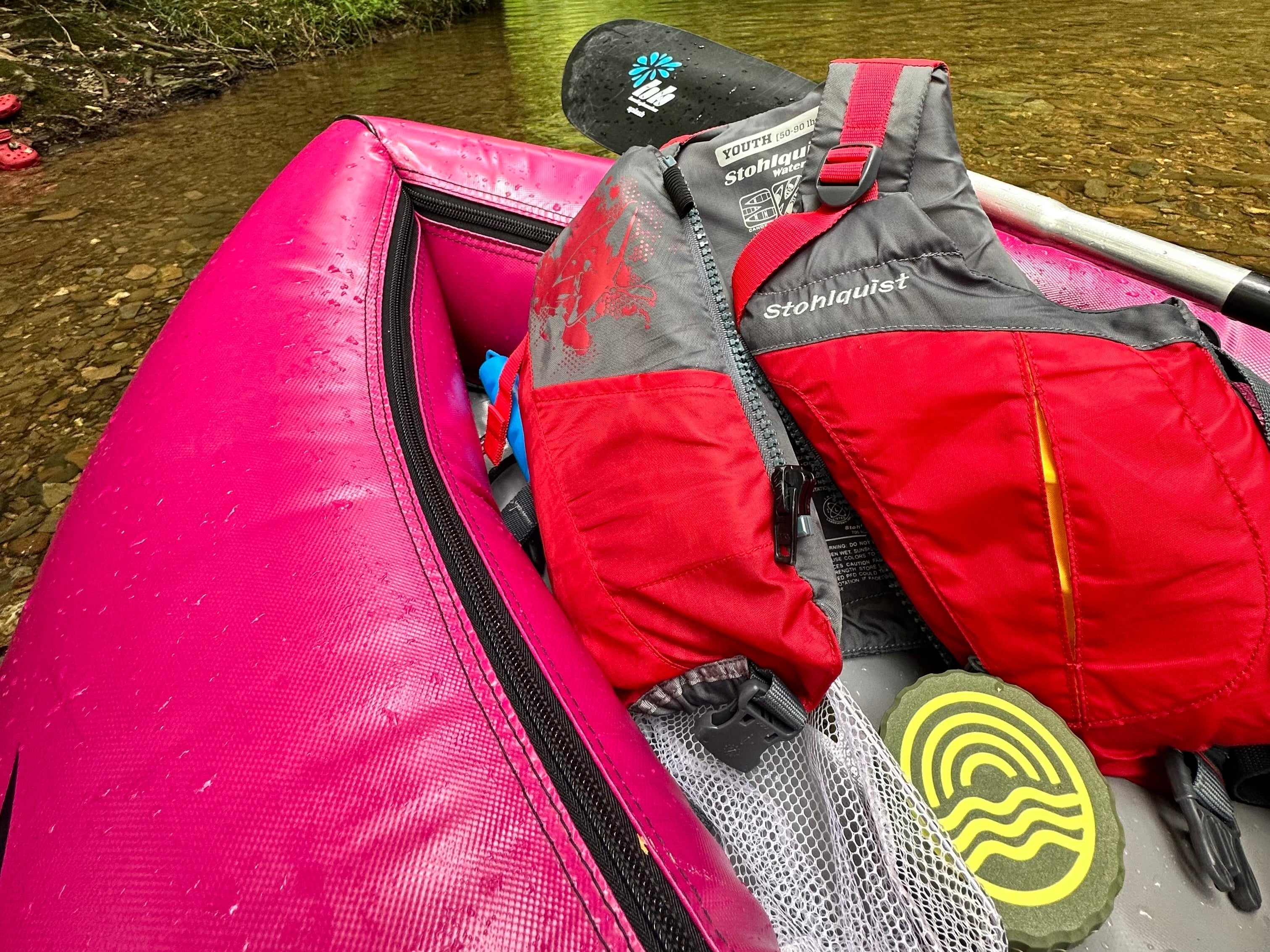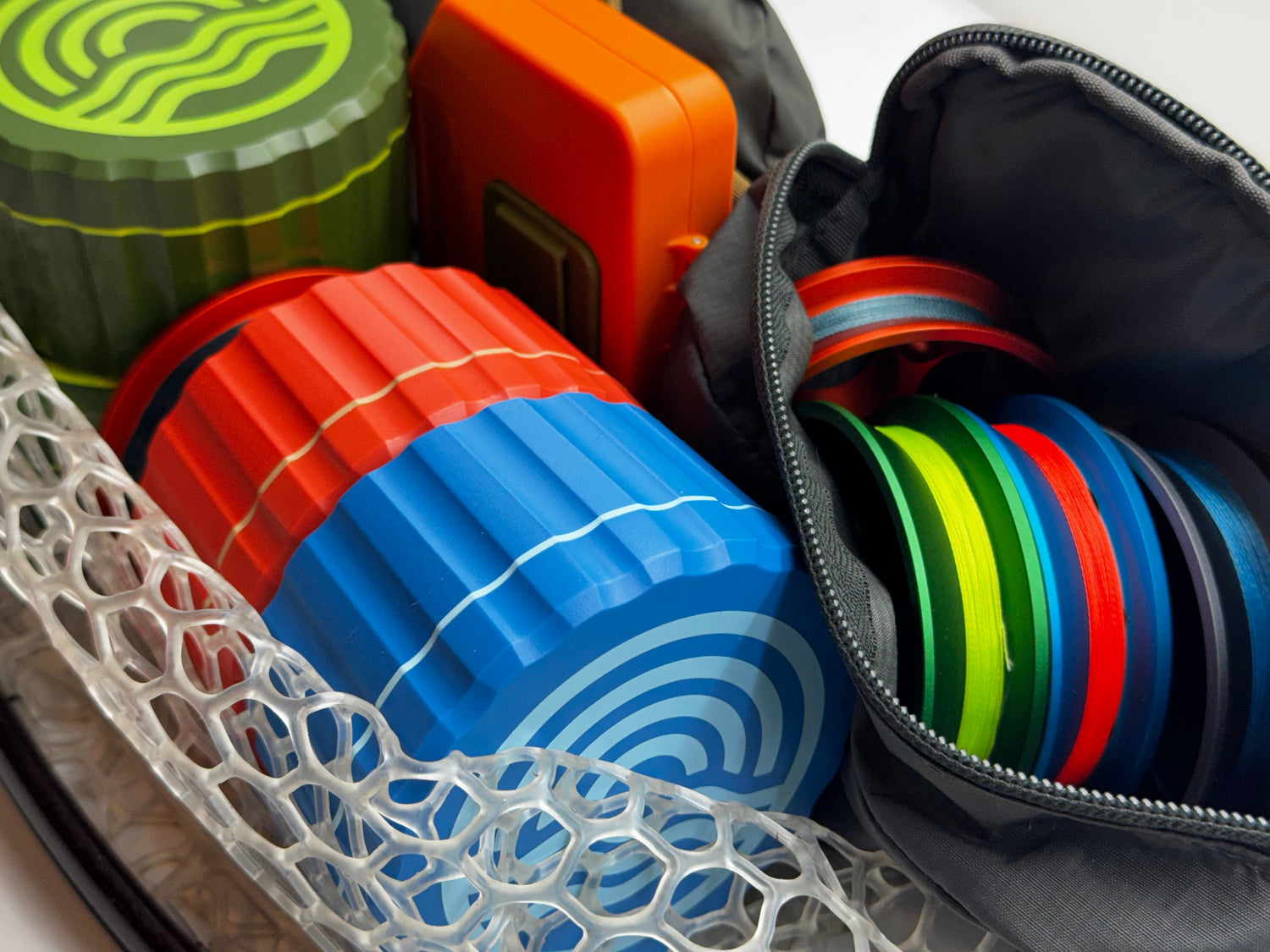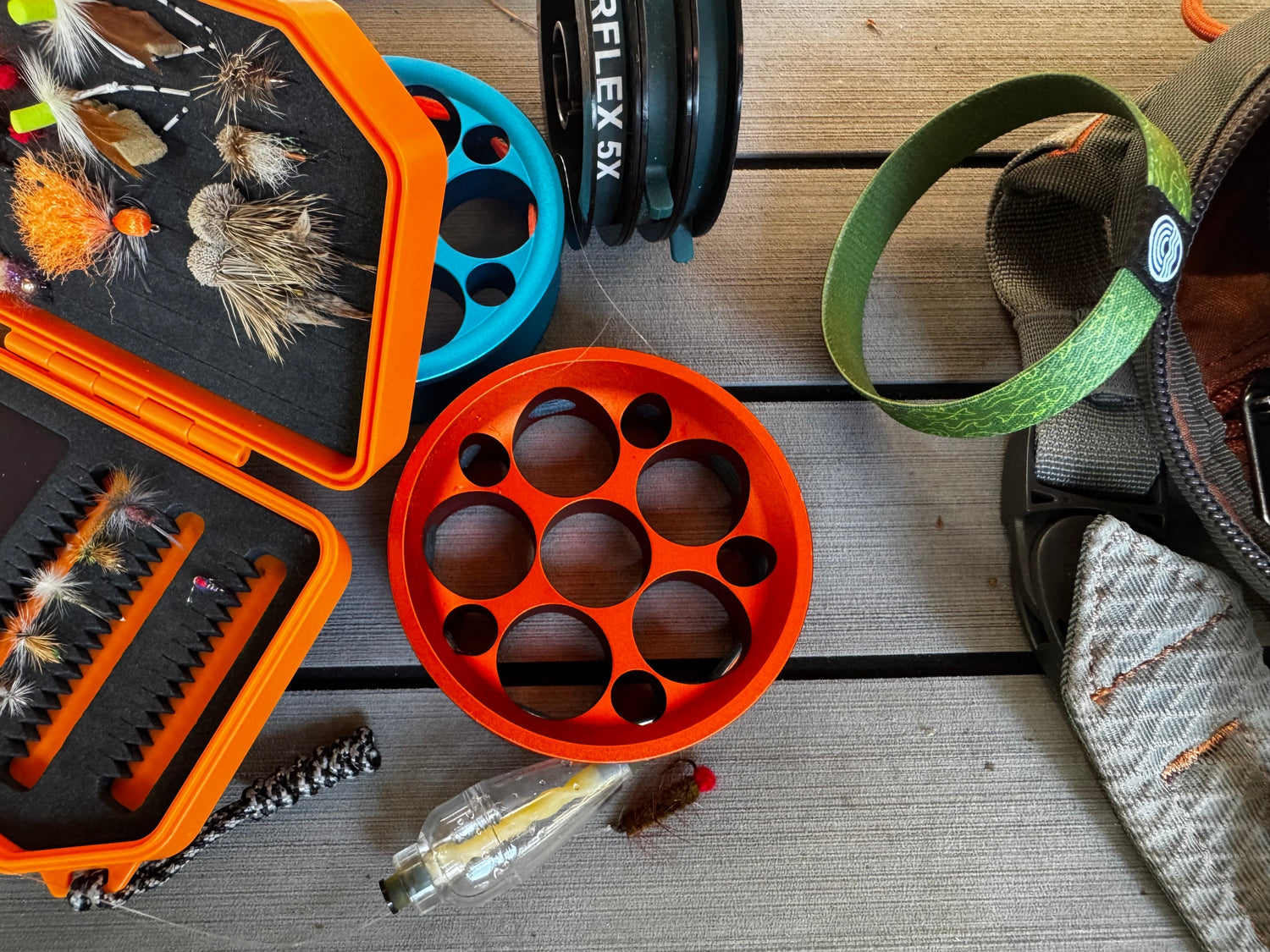The Perfect Pairing: Hand Reel Fishing and Paddle Sports

There's something inherently harmonious about fishing from a kayak or canoe. The quiet approach, the intimate connection with the water, the ability to access hidden spots unreachable by larger craft—these elements create a fishing experience unlike any other. Yet traditional fishing gear, with its lengthy rods and complex reels, often fights against the confined space and unique dynamics of paddle craft.
Enter the GoReel: a revolutionary hand reel system that seems purpose-built for the paddle angler. "When we designed the GoReel, we were thinking about minimalist fishing in all environments," explains Mike McKearin, founder of Crystal Creek Gear. "But we quickly discovered that kayak and canoe anglers were among our most enthusiastic adopters. The system solves so many challenges unique to paddle craft fishing."
This comprehensive guide explores how to effectively integrate your GoReel into kayak and canoe fishing adventures, transforming potential frustrations into seamless experiences on the water.
Why GoReel is Perfect for Paddle Craft
Traditional fishing rods present numerous challenges for kayakers and canoeists:
Space Limitations Solved
The average fishing kayak cockpit offers precious little space for gear management. A 7-foot rod becomes an awkward liability when you need to paddle, land a fish, or navigate tight spaces.
The GoReel's compact design—smaller than a smartphone—means it occupies minimal space in your already-limited kayak or canoe real estate.
Simplified Transport and Transitions
Paddle sports involve constant transitions: from paddling to fishing, from open water to cover, from active casting to drifting. Traditional gear complicates these transitions.
With the GoReel system:
- No need to secure rod holders to your craft
- No risk of rods breaking during transport to launch sites
- No awkward moments trying to stow a rod while managing your paddle
- Instant transition from paddling to fishing and back again
Durability in Demanding Conditions
Paddle craft fishing often involves rough handling—sliding over logs, bumping against rocks, or navigating through brush. The GoReel's rugged construction withstands these challenges.
"I've dropped my GoReel in the bottom of my kayak countless times, where it sits in puddles and gets stepped on," Kevin P notes. "It still performs flawlessly. Try that with a $300 spinning reel."
Perfect for Minimalist Paddlers
Many kayakers and canoeists embrace these craft precisely because of their simplicity and connection to traditional methods. The GoReel aligns perfectly with this philosophy.
Kayak vs. Canoe Considerations for GoReel Fishing
While both kayaks and canoes offer excellent platforms for GoReel fishing, each presents unique considerations:
Kayak Advantages and Adaptations
Stability Profile: Modern fishing kayaks, particularly sit-on-top models, offer remarkable stability. This stable platform allows for effective casting even with the shorter lever arm of hand reel fishing.
Seating Position: The lower seating position in kayaks requires adaptation of casting techniques. The side-arm cast becomes particularly effective, as it works with the lower center of gravity rather than against it.
Storage Solutions: Most fishing kayaks feature multiple hatches and compartments. Designate a specific, easily accessible location for your GoReel and tackle—ideally within arm's reach of your seat.
Hands-Free Options: Many kayaks allow for hands-free propulsion through pedal drives or motors. These systems pair exceptionally well with the GoReel, allowing simultaneous movement and fishing.
Canoe Advantages and Adaptations
Elevated Casting Position: The higher seating in canoes provides better visibility into the water and more leverage for casting. This height advantage allows for more traditional casting motions with the GoReel.
Greater Interior Space: Canoes typically offer more open interior space, making it easier to manage line and land fish. This space allows for more comfortable management of the GoReel system.
Tandem Possibilities: Two-person canoes create unique opportunities for cooperative fishing—one person can paddle while the other fishes, then switch roles without the complexity of managing multiple rods.
Traditional Appeal: There's a natural synergy between traditional canoes and the time-honored approach of hand reel fishing. Many canoeists appreciate this connection to fishing's historical roots.
Essential Gear Setup for Paddle Fishing with GoReel
Beyond the GoReel itself, successful paddle fishing requires thoughtful gear selection and organization:
Securing Your GoReel While Paddling
The GoReel's compact size creates multiple options for secure storage while paddling:
- Attach to a retractable gear tether clipped to your PFD
- Store in a small waterproof container secured to your craft
- Keep in a dedicated PFD pocket for instant access
- Use a small carabiner to clip to existing kayak/canoe attachment points
"I use a simple coiled lanyard attached to my PFD," McKearin shares. "The GoReel stays secure against my chest when paddling but extends easily when I spot a fishing opportunity. No fumbling with rod holders or complex systems."
Waterproof Storage Solutions
Water is an inevitable presence in paddle craft. Protect your tackle with:
- Small waterproof boxes for lures and terminal tackle
- Dry bags for larger gear items
- Sealed containers with foam inserts to organize and protect gear
- Waterproof phone cases for fishing apps and photography
Paddle Management Systems
When it's time to fish, you need a secure place for your paddle:
- Paddle clips installed on kayak gunwales
- Bungee systems that secure the paddle alongside the craft
- Paddle leashes that allow the paddle to float alongside while fishing
- For canoes, a paddle hook that secures the paddle to the gunwale
Anchor Systems and Position Control
Maintaining position while fishing from paddle craft is crucial:
- Compact anchor systems designed for kayaks and canoes
- Stake-out poles for shallow water fishing
- Drift socks to slow movement in windy conditions
- Brush grippers for securing to structure in moving water
Rigging Your Paddle Craft for GoReel Success
Thoughtful modifications to your kayak or canoe can enhance your GoReel fishing experience:
Attachment Points and Organization
- Install small pad eyes or gear tracks at strategic locations for securing equipment
- Add bungee cordage in X-patterns across open areas to tuck gear under
- Consider a small gear arm that swings out from the cockpit for temporary tackle placement
- For canoes, attach small utility containers to thwarts for organized gear storage
DIY Modifications
Simple, inexpensive modifications can dramatically improve your paddle fishing experience:
- Add foam padding in the bottom of the craft to deaden sound and protect gear
- Install small cleats for securing anchor lines
- Create a simple dashboard area near your seat for frequently used items
- Add reflective tape for improved visibility during dawn/dusk fishing
GoReel Casting Techniques from Seated Position
The confined space and stability considerations of paddle craft require adapted casting techniques:
This technique minimizes height and keeps your center of gravity low:
1.Hold the GoReel at waist level
2.Swing the lure in a horizontal pendulum motion parallel to the water
3.Release at the forward point of the swing
4.Control distance by adjusting the length of line and swing force
The Flick Cast
Ideal for precision placement around structure:
1.Hold a small amount of line (2-3 feet) between the GoReel and lure
2.Use a quick wrist snap to propel the lure
3.Control direction with the angle of your wrist movement
4.Perfect for dropping lures into tight spaces between lily pads or brush
Species Targeting Strategies

Different fish species require adapted approaches when fishing from paddle craft with your GoReel:
Bass and Panfish Along Shorelines
- Position your craft parallel to shoreline structure
- Use your paddle craft's stealth to approach shallow areas
- Cast parallel to the shore rather than perpendicular when possible
- Work lures from deeper water toward the shallows
Trout in Moving Water
- Approach from downstream when possible
- Position at the tail of pools and cast upstream
- Use your craft to hold position in eddies while fishing seams
- Let the current do the work of presenting your lure naturally
Open Water Species
- Drift fishing becomes highly effective for suspended fish
- Use electronics to locate schools or structure
- Consider trolling techniques by trailing line behind while paddling
For deeper species, add weight incrementally to achieve desired depth
Navigation and Positioning for Optimal Fishing
Strategic positioning is perhaps the greatest advantage paddle craft offer:
Reading Water from the Paddle Perspective
Your lower vantage point in a kayak or canoe offers unique insights:
-
Look for subtle current breaks indicating submerged structure
-
Watch for surface disturbances that betray fish activity
-
Notice temperature changes as you paddle across different areas
-
Observe insect activity concentrated in specific zones
Silent Approach Strategies
- Paddle craft allow for nearly silent positioning:
- Use the wind and current to your advantage when approaching spots
- Master the art of the single, silent stroke rather than multiple noisy ones
- Approach structure from the shadow side when possible
- In clear water, stay low to reduce your silhouette
Positioning Relative to Structure
- The maneuverability of paddle craft allows for optimal positioning
- Place your craft to cast parallel to structure rather than across it
- Position with the sun at your back when possible for better visibility
- For moving water, set up slightly upstream of target areas
- In wind, position upwind and use controlled drifting
Safety Considerations for Paddle Anglers

Safety becomes even more critical when combining fishing with paddling:
PFD Selection and Usage
- Always wear your PFD—no exceptions
- Choose a fishing-specific PFD with pockets for GoReel and tackle
- Consider high-visibility colors to be seen by other boater
- Ensure your PFD doesn't restrict casting motion
Environmental Stewardship from Paddle Craft
The intimate connection with water that paddle craft provide creates both opportunity and responsibility:
Leave No Trace Principles
- Pack out all fishing materials, including line trimmings
- Be especially careful with soft plastic lures, which are harmful if ingested by wildlife
- Consider using biodegradable alternatives when available
- Take photos of your catch quickly and release fish promptly
The Integrated Experience
The combination of paddle craft and GoReel fishing represents more than just a practical solution to the challenges of fishing from kayaks and canoes—it's a return to a more connected, mindful approach to angling.
"There's a special synergy between paddle sports and hand reel fishing," McKearin reflects. "Both strip away complexity to focus on the essence of the experience. Both require you to develop skill rather than rely on technology. And both connect you to traditional practices that have sustained humans for generations."
Whether you're a dedicated kayak angler looking to simplify your approach, a canoeist seeking to add fishing to your paddling adventures, or an outdoor enthusiast wanting to maximize your time on water, the paddle-fishing combination with GoReel offers rich rewards.
The next time you slide your kayak or canoe into the water, consider leaving the rods behind and slipping a GoReel into your PFD pocket. You might discover that less truly is more when it comes to fishing from paddle craft—less gear, less complexity, less distance between you and the fish you seek.





